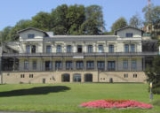
Rolandseck
Encyclopedia
Rolandseck is a borough of Remagen
in Rhineland-Palatinate
, Germany
.
 The place consists almost entirely of villas and is a favorite summer resort. Crowning the vine-clad hills behind it lie the ruins of the castle, a picturesque ivy-covered arch, whence a fine view is obtained of the Siebengebirge
The place consists almost entirely of villas and is a favorite summer resort. Crowning the vine-clad hills behind it lie the ruins of the castle, a picturesque ivy-covered arch, whence a fine view is obtained of the Siebengebirge
and the Rhine valley as far as Bonn
. Immediately below Rolandseck in mid-river is the island of Nonnenwerth
, on which is a nursing school under the conduct of Franciscan nuns, established in 1850. The convent which formerly stood here was founded in 1122 and secularized in 1802. Tradition assigns the foundation of the castle of Rolandseck to Charlemagne
's paladin, Roland
. It was certainly built at a very early date, as it was restored by Frederick, archbishop of Cologne
, in 1120, and it was a fortress until the end of the 15th century.
Remagen
Remagen is a town in Germany in Rhineland-Palatinate, in the district of Ahrweiler. It is about a one hour drive from Cologne , just south of Bonn, the former West German capital. It is situated on the River Rhine. There is a ferry across the Rhine from Remagen every 10–15 minutes in the summer...
in Rhineland-Palatinate
Rhineland-Palatinate
Rhineland-Palatinate is one of the 16 states of the Federal Republic of Germany. It has an area of and about four million inhabitants. The capital is Mainz. English speakers also commonly refer to the state by its German name, Rheinland-Pfalz ....
, Germany
Germany
Germany , officially the Federal Republic of Germany , is a federal parliamentary republic in Europe. The country consists of 16 states while the capital and largest city is Berlin. Germany covers an area of 357,021 km2 and has a largely temperate seasonal climate...
.

Siebengebirge
The Siebengebirge is a German range of hills to the East of the Rhine, southeast of Bonn, consisting of more than 40 mountains and hills. It is located in the municipalities of Bad Honnef and Königswinter. It is of volcanic origin and came into being between 28 and 15 million years ago...
and the Rhine valley as far as Bonn
Bonn
Bonn is the 19th largest city in Germany. Located in the Cologne/Bonn Region, about 25 kilometres south of Cologne on the river Rhine in the State of North Rhine-Westphalia, it was the capital of West Germany from 1949 to 1990 and the official seat of government of united Germany from 1990 to 1999....
. Immediately below Rolandseck in mid-river is the island of Nonnenwerth
Nonnenwerth
Nonnenwerth is an island near Bad Honnef in the Rhine, administratively part of Remagen in Rhineland-Palatinate.-Religious houses:The island is mainly known as the site of a Benedictine nunnery, later a Franciscan convent.-First foundation:...
, on which is a nursing school under the conduct of Franciscan nuns, established in 1850. The convent which formerly stood here was founded in 1122 and secularized in 1802. Tradition assigns the foundation of the castle of Rolandseck to Charlemagne
Charlemagne
Charlemagne was King of the Franks from 768 and Emperor of the Romans from 800 to his death in 814. He expanded the Frankish kingdom into an empire that incorporated much of Western and Central Europe. During his reign, he conquered Italy and was crowned by Pope Leo III on 25 December 800...
's paladin, Roland
Roland
Roland was a Frankish military leader under Charlemagne who became one of the principal figures in the literary cycle known as the Matter of France. Historically, Roland was military governor of the Breton March, with responsibility for defending the frontier of Francia against the Bretons...
. It was certainly built at a very early date, as it was restored by Frederick, archbishop of Cologne
Archbishopric of Cologne
The Electorate of Cologne was an ecclesiastical principality of the Holy Roman Empire and existed from the 10th to the early 19th century. It consisted of the temporal possessions of the Roman Catholic Archdiocese of Cologne . It was ruled by the Archbishop in his function as prince-elector of...
, in 1120, and it was a fortress until the end of the 15th century.

